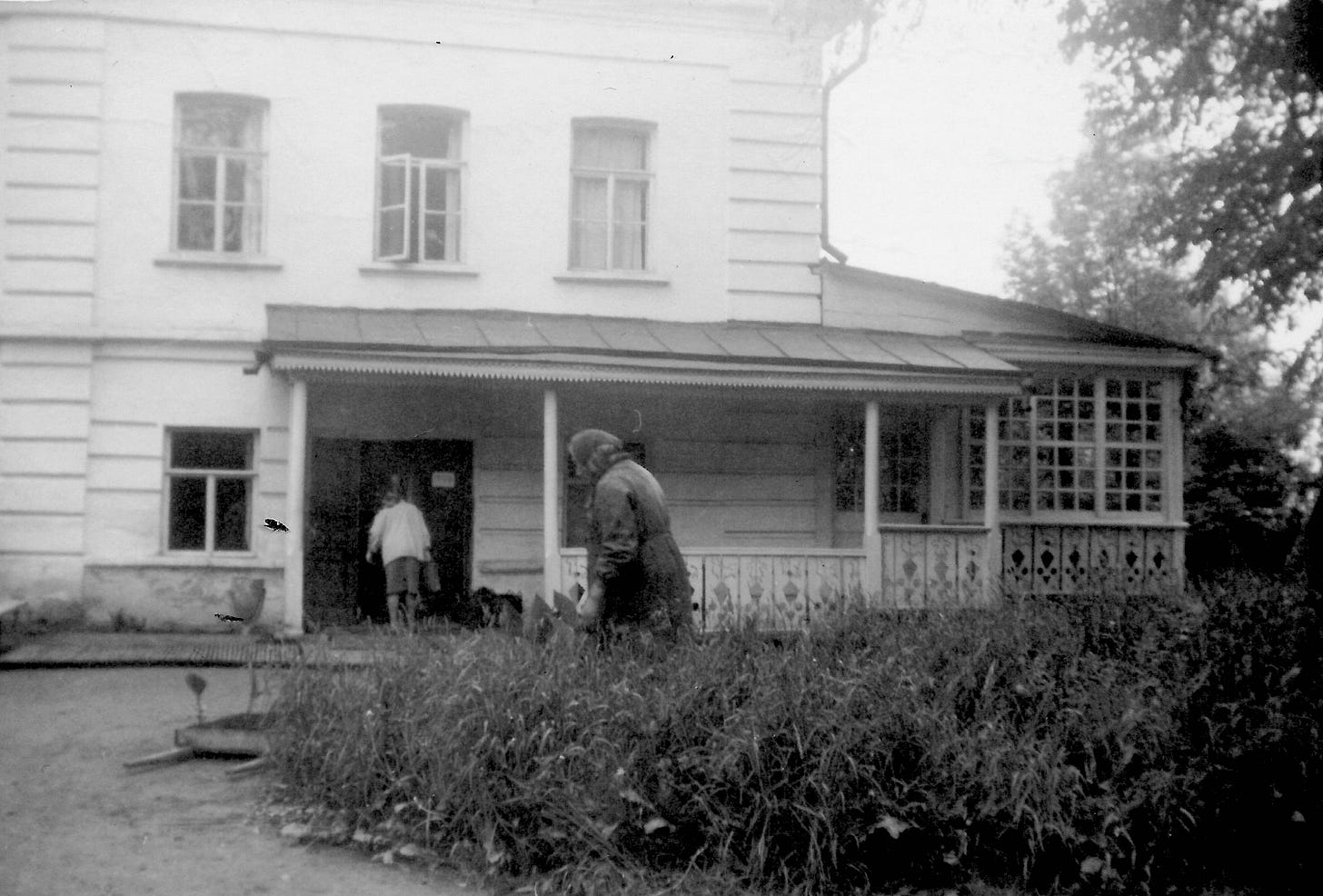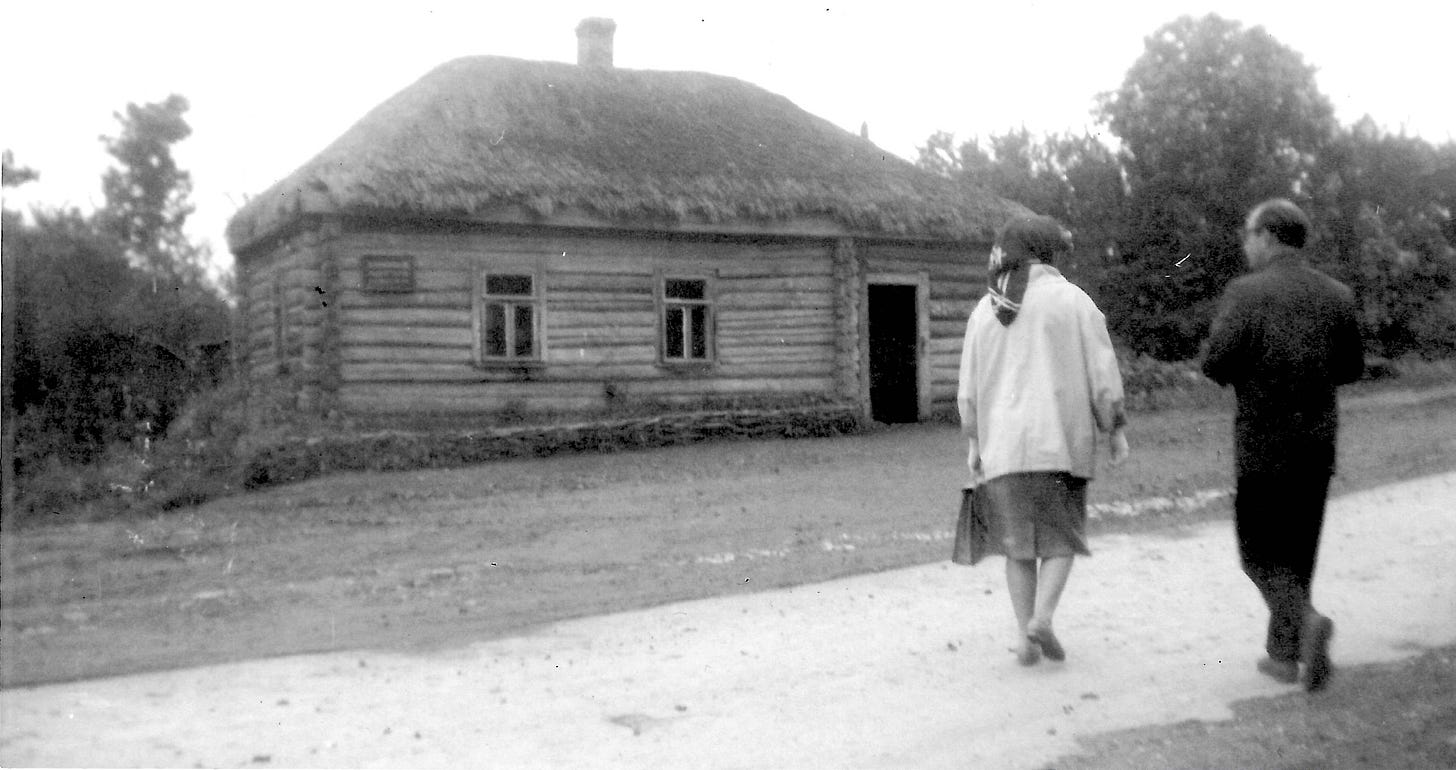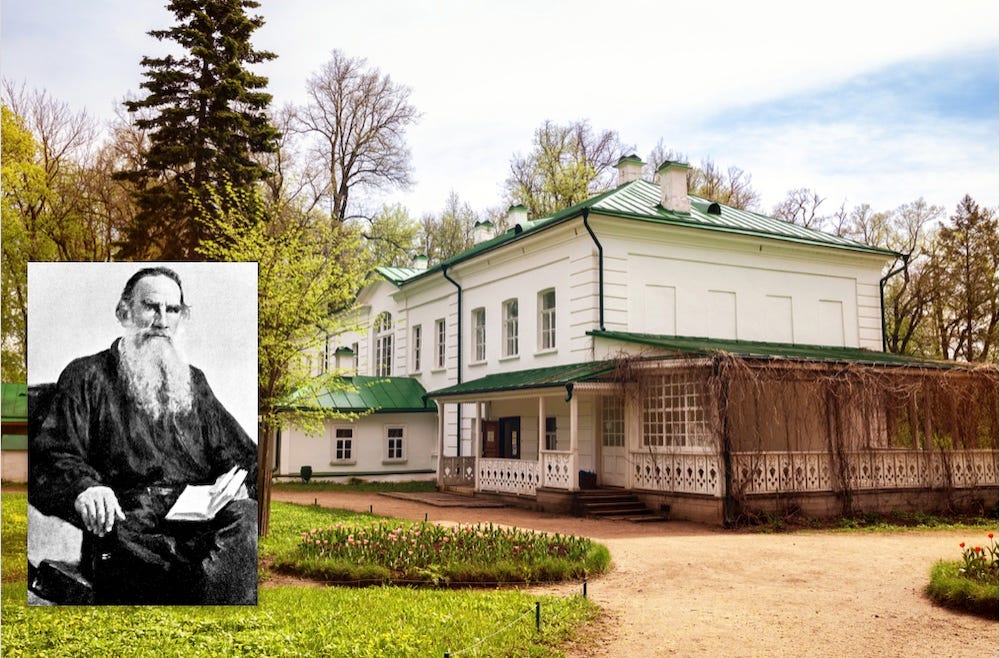‘Love,’ he said, ‘is the way. Love!’
Issue #9 Diary Notes of a European Journey (Mainly about Russia) May 25 -June 26, 1962
In this edition, playwright Paul Green continues his tour of Russia with his guide Tanya—on this day to visit the birthplace of Leo Tolstoy. The black and white photos included here were presumably taken by Paul Green himself.
Monday, June 4, 1962
Soon we came to the little Yasnaya Polyana village. There was the railroad station where Tolstoy had taken the train for many a trip and where he took his last cold, death-bringing trip in the autumn of 1910, when he fled from his home, his wife and his long-abhorred outward way of life. The gates to the Tolstoy estate were there ahead to the right—two round-tipped and topped plastered constructions maybe about five feet in diameter and ten feet in height, I guess. We were stopped at the gate by two policemen in their dark uniforms (decorated in red bandings) and told we’d have to leave the car there. So Tanya told the driver to wait and we set out on foot.
As we passed through the gates onto a black-topped roadway we crossed a big dam—the roadway—some twenty five or more feet high above the ravine on the right with a lake of several acres dammed up on the left, the same lake where Tolstoy’s wife had once tried to drown herself.
“This is a tremendous dam,” I said, “and from the size of the willow trees growing along the edge of it, it must have been here a long, long time.”
“Yes, it has,” Tanya replied as we hurried along, for it had begun to rain harder. “It was built by the serfs.”
“Golly, with shovels, picks and wheelbarrows—not even wheelbarrows, perhaps.”
“Sir?”
“It must have taken a long time to build it, I mean.”
“Yes.”
We hurried on up the road which inclined before us. There were pines, maples and birches on either side, and then there off to the left a young apple orchard with the white-washed bodies of the trees gleaming through the lowering weather.
“How many acres are there in this estate?”
“When Tolstoy’s father owned it there were about a thousand. Now there are about six hundred, I think. We’ll ask the guide,” she said. “They farm here still as they did in Tolstoy’s time, sell apples, grain, hay—just the same.”
A bird making the clear call of a cardinal kept singing in the woods and hedges now beyond the apple orchard on the right.
“What bird is that?” I asked.
“I don’t know.” She smiled at me with a faint look of reprimanding as much as if to say “you mustn’t expect me to know everything.”
“Of course it couldn’t be a nightingale waked up on the wrong side of the bed?” I asked.
“Sir?”
“Never mind. It’s beautiful anyway.”
She laughed. “A nightingale! You don’t expect nightingales to sing the daytime, do you? If they did, they’d have to change their name.”
“Yes, of course.”
She was panting for breath, so I slowed down. I had been so anxious to get to Tolstoy’s house.
Soon we rounded a bend in the in the road and came full on the end of the house. The first thing that struck my notice was a big gnarled old—it looked like some kind of dark-bodied oak tree—linden tree, which had been pruned and doctored and seemed in fairly good health. A plank seat encircled it. Tanya pointed to the tree. “That’s a very famous tree there. There the peasants used to come and sit and wait for Tolstoy to see them. They all loved him, of course, and called him by his first name in a most comradely way.”
Two women came by carrying a heavy litter between them on which were a number of calla lily-like plants. They set the load down and began to dig deep with their bare red hands into a rounded pile of earth—much like the potato hills we used to have when I was a boy in Harnett County—and bury the plants.

Tanya went up to the door of the house and I took stock. The building was much as I had expected from all my reading, but maybe a little less imposing. In fact, it wasn’t imposing at all…Off to the left was a sort of woodshed where some men were repairing a wagon crate, hammering and talking away. Tanya came back and said they had a special guide for us. And now it looked like we would need it, for a horde of school children began flooding up the road and around the yard.
We were now met by a fresh-faced young woman, yellow haired, blue eyed —Hitler would have liked her—who asked if we wanted to go to the toilet before we went through the house. I told her I was all right, still in good shape, but Tanya said she had to be excused. She hurried off toward a building several hundred yards through the trees. I walked around in the yard, looked at the crooked bed of pansies in bloom, the rank unkempt grass and dank growth of dandelion leaves, and watched the young people arriving. When Tanya returned, she explained she had to go a long way and now we would go in.
A young man now came out to meet us—a smiling, ingratiating young man who spoke in a swift but deferential voice welcoming me to Yasnaya Polyana. He kept his half-apologetic, kow-towing manner all through the tour, and I soon realized that this was his way with everybody in public, for once one of the cleaning women got in our way on the tour and he really bawled her out…He had a way of tapping his soft plump womanish hands, the fingers of them, together as the words of information flowed through his full lips in his always softened-assertion manner. He was of small height and slightly bald, and apple-cheeked as a young boy priest.

We went inside, he pushing his way—now rough and dominant indeed—right through the school children, as if to say, ”Get out of the way, you clutter-ups, and let me through with my important business, my important guests.” The children looked at me and I looked at them and smiled as friendly as I could. They smiled friendly, too…
Our guide took us through the door into what he called the vaulted room, which had once been a sort of smokehouse room. Iron rings were still in the ceiling from which hams and other farm produce used to hang—in the old days…
I was immediately struck by the simplicity of these rooms on the ground floor—wide, foot-worn and unpainted pine planks for flooring, plain doors, windows and casings, plain walls except for the pictures, miniatures, etc. that were hung on them—everywhere simplicity, strength, too, for the walls were about two feet thick. Our young, deferential and knowledgeable guide was full of his subject and passed from one room to the other talking volubly, and I was greedy for every word I got through the interpreter—and now and then I could get some sense of what he was saying without her help, too.
“This vaulted room was for a long time Tolstoy’s study. He didn’t mind the iron rings in the ceiling and the pieces of bars across the window—there you can see the marks of where the bars used to be—no, no, he didn’t mind. In fact he said he liked it that way, it made him feel close to the earth, the earth from which the farm produce came. The room we just crossed to get in here—to keep away from the children”—and he smiled sweetly and tapped his fingers, five tipped against five, an extra time or two—“that was the doctor’s room, Tolstoy’s doctors, doctors for him and the family. We’ll turn back to that presently. Yes, Tolstoy had several illnesses, some of them serious. No, I don’t think he ever had an operation in a hospital. I don’t remember any record of such. But he did have several severe illnesses, especially in later life. He had pneumonia at least three times, and one time he almost died. But his strong constitution pulled him through. Once he tore some what do you call ligaments in his leg and got himself a wheelchair so he could move about. It was fitted with a sort of board in front, a lap board on which he could write. Oh, no, he never stopped writing.
“Of course, he stopped when he was doing other work—plowing, cutting wood, making shoes, or other things. Yes. I think he liked cutting wood better than anything except walking. He loved walking. Hardly any man in this region— serf or laborer or whatever—ever walked as much as Leo Tolstoy. Why do we call him Leo? Well, we call him Lev, too, Lyoff, also. But Leo means lion. So perhaps that’s why he’s often called Leo Tolstoy—Lion Tolstoy—except he’d not like to be classed with that animal—no, too fierce, cruel. Tolstoy hated cruelty, force. ‘Love,’ he said, ‘is the way. Love!’ Of course, we now don’t agree with this part of his religion or his philosophy—this philosophy of Christ, this turn the other cheek, this softness, this, well, idealism. No!” And he smiled gently, tenderly. “We are hard, I mean, practical. We are materialists. As an artist he was a materialist, a great realist, as a philosopher he was a mistaken idealist. Yes, he was a man of contradictions, but all Russia loves him. Oh, but I mean a different kind of love. Not a Christ love. We love him for the wonderful way he laid bare the working of the bourgeoisie, showed the evil of their system. He was an x-ray and through the x-ray the doctors can make the diagnosis. Tolstoy’s realism helped Lenin and the leaders of the Revolution to diagnose and prescribe the cure for a sick society. Lenin wrote seven fine articles, none better, on Tolstoy—he showed this contradiction in him, but at the same time he called him one of the great literary giants of all time. And Lenin was responsible for the saving of Tolstoy’s house in Moscow and making it into a museum. In fact, he called on all the Russian people to cherish his memory and read his novels, his early stories and his plays. No, not his philosophical and religious works, except to study them objectively and see where he went astray. No, I don’t know whether Lenin’s articles have been translated into English or not—those on Tolstoy you mean. Yes, well, you might try the foreign bookstore in Moscow. Now to get back to this room, this vaulted room. It was once a place to store meat and dairy products. It once had a stone floor in the old days of the serfs—in the days of Prince Volkovsky, Tolstoy’s grandfather. Along about the time the serfs were freed, say around 1860, a plank floor was put in. Then later it served as a dining room, then a nursery and finally a study. It’s not a large room, and once this was a small house. It was added to from time to time. It now has 16 rooms. Tolstoy himself had it added to at least twice. This was his study for about 20 years, more than that perhaps. Here it was he worked out the story of War and Peace and wrote a great deal of it.
“He carried on his writings in Moscow when he went there in the winter. When the family grew larger—he had 13 children, you may remember—yes, some of them died, four, I think. When the family increased, he moved his study upstairs. We’ll see that later. This was turned into a nursery for the little ones. His wife said for years this was her domain, here her life was spent, here she nursed and cared for her children. Yet, all the while, when she put the children to bed or turned them over to the nurse or governess, she was busy copying her husband’s writings and getting them ready for the printer. Or, if not that, then she was crocheting bed-covers, knitting sweaters or making shirts and underwear and smocks for Tolstoy. She made all his shirts on a sewing machine we’ll see later—a very old one, but she liked it and used it. About 1887 Tolstoy took this room back for his study and it remained that till, well, say 1902 or 1903. Here he wrote a number of his philosophical works, his religious sermons and did the main work—it’s difficult to say just which works were begun and finished in this room, for as I said, Tolstoy carried on his writing when he went to Moscow. But from the records gathered from his wife and sons we are pretty certain that he completed in this room—What is Art? The Living Corpse, Resurrection, The Kreutzer Sonata, The Young Tsar, and Haji Murat. And, of course, he wrote here much of War and Peace. And Anna Karenina here? No.
“In 1891 the fine artist Repin painted his beautiful picture of Tolstoy at work in this room. Tolstoy was sitting at the table in front of this window there —look, you see there is a good view down across the garden and into the woods—he dearly loved those woods—and he showed on the walls and in the room the farm tools with which Tolstoy loved to work—you’ve seen the picture? We’ll look at it later—a shovel, a scythe and woodsaw hanging on the wall, too, some of his simple clothing and an old hat. In the picture Tolstoy is wearing his peasant smock. Yes, no doubt his wife made it for him, though she much disliked him acting like a peasant…It was in this room in 1906 Tolstoy’s favorite daughter Maria died. He was holding her in his arms as she died. She was his favorite. He never—you might say—he never got over that. He said she was a source of warmth he needed as he grew very old…
“In this room many dramatic things connected with Tolstoy’s life happened. Here many famous guests stayed, even at the time it was Tolstoy’s study…Here he received some Americans. Yes, that’s a picture of William Jennings Bryan. He came here and stayed two days. He and Tolstoy had many discussions. Tolstoy was always eager to learn what was going on in other countries…When Tolstoy was working on his Alphabet he started a school for peasants in this room. Yes, quite a number came. No, I don’t know how they all got into his room…He wanted everybody in Russia to learn to read and write. And now, at last, we can. In your country I hear it is very different…

“Tolstoy lay in state in this room—his body, I mean. The coffin was placed there below the niche where the bust of his brother Nicholas is, and yes, the picture of Bryan, looking down on the coffin, and Dickens above…Tolstoy loved Charles Dickens, loved him for his interpretation of the lives of the poor people. Oh, yes, he read him in the original, read him easily. Now that we mention languages, I tell you that he was a very great linguist. He spoke many languages almost perfectly. In addition to his Russian native tongue came French. Everybody in his house could speak French. Then he knew German as well as a native German, and English, too. He corresponded with many people in their own language. I should say he knew how to read fifteen or sixteen languages and he could speak most of them. He studied and learned Greek, knew Latin. And late in life he started on Hebrew. He had already learned Arabic. He wanted to read the Old Testament in the original…
“Yes, here his coffin was placed when he was brought home. That stool was for people to step up on to be able to kiss him as he lay in the coffin. They came through that door there from the front and passed on out through there into the garden. Thousands and thousands came—an endless procession. It was cold. A deep snow lay on the the ground, but they came.”
(To be continued)




